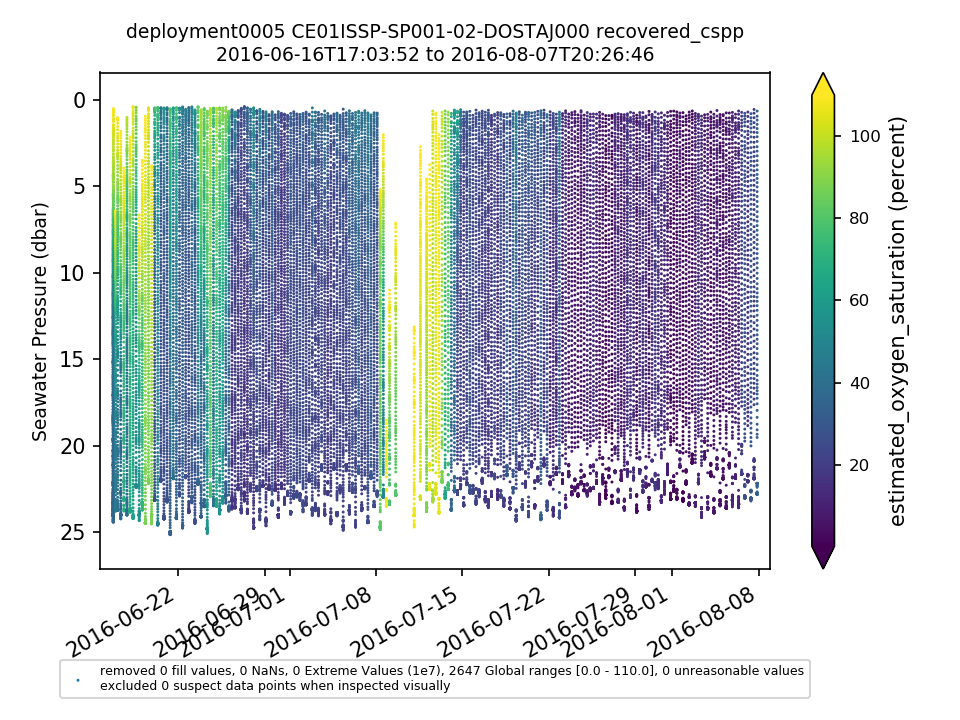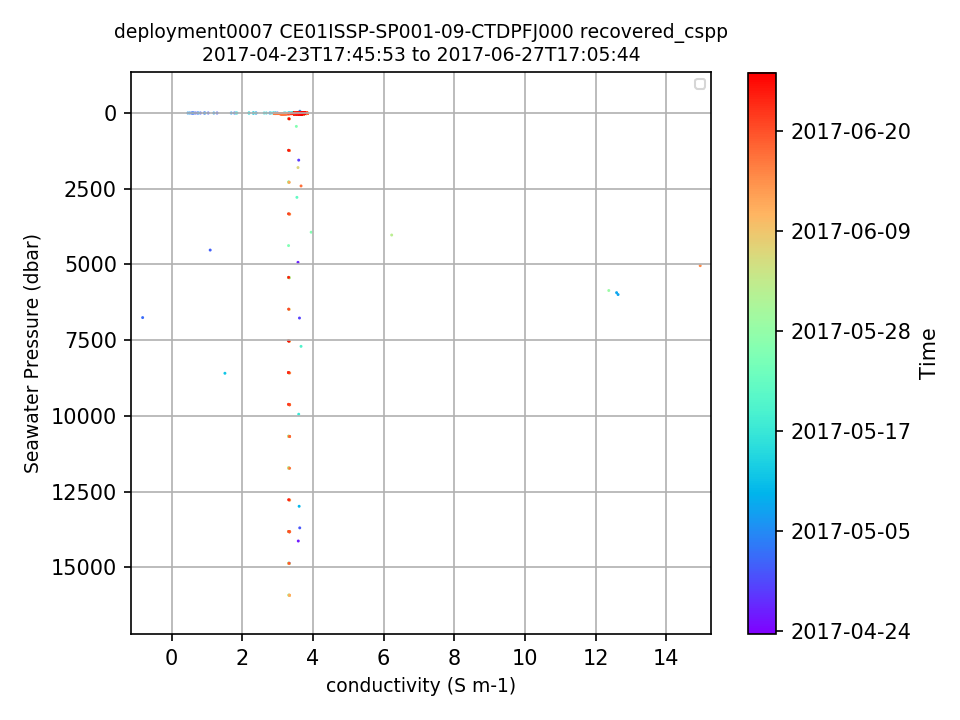Notes
Sort by:| Metadata | Start Date | End Date | Comment |
|---|---|---|---|
|
CE01ISSP-SP001-02-DOSTAJ000 Deployment: 5 |
|||
|
CE01ISSP-SP001 |
|||
|
CE01ISSP-SP001-02-DOSTAJ000 Deployment: 1 |
estimated_oxygen_saturation is an array of fill values for this deployment. By Lori Garzio, on 7/1/19 |
||
|
CE06ISSM-RID16-02-FLORTD000 |
pressure_depth is an array of fill values for every deployment. This variable should contain valid pressure data. By Lori Garzio, on 6/28/19 |
||
|
CE02SHSP-SP002-05-NUTNRJ000 |
nitrate_concentration, nutnr_nitrogen_in_nitrate, ctd_psu, ctd_temp, ctd_dbar are arrays of -1 and pressure_depth is an array of zeros. By Lori Garzio, on 6/28/19 |
||
|
CE02SHSP-SP002-04-OPTAAJ000 |
According to Roesler and Barnard (Optical proxy for phytoplankton biomass in the absence of photophysiology: Rethinking the absorption line height, Methods in Oceanography, 2013), “absorption meters are highly prone to biofouling, particularly biofilms which not only attenuate the collimated beam but also impact the scattering properties of the optical surfaces and tubes. In productive coastal waters biofouling can have significant impacts (i.e. 10% of the signal) within one to two weeks”. By Lori Garzio, on 6/28/19 |
||
|
CE02SHSP-SP002 |
There are no global ranges in the system for every instrument on CE02SHSP-SP002. By Lori Garzio, on 6/28/19 |
||
|
CE09OSSM-RID27-01-OPTAAD000 |
There is no pressure variable in the .nc files. This should be a coordinate. By Lori Garzio, on 6/28/19 |
||
|
CE09OSSM-RID27-01-OPTAAD000 |
According to Roesler and Barnard (Optical proxy for phytoplankton biomass in the absence of photophysiology: Rethinking the absorption line height, Methods in Oceanography, 2013), “absorption meters are highly prone to biofouling, particularly biofilms which not only attenuate the collimated beam but also impact the scattering properties of the optical surfaces and tubes. In productive coastal waters biofouling can have significant impacts (i.e. 10% of the signal) within one to two weeks”. By Lori Garzio, on 6/28/19 |
||
|
CE09OSSM-RID27-01-OPTAAD000 Deployment: 4 |
There are no recovered_host data available for download for this deployment. According to the ingest csv, the raw data files are missing. These files should be uploaded and ingested, or the dataset should be annotated. By Lori Garzio, on 6/28/19 |
||
|
CE09OSSM-MFD37-01-OPTAAC000 |
There is no pressure variable in the .nc files. This should be a coordinate. By Lori Garzio, on 6/28/19 |
||
|
CE09OSSM-MFD37-01-OPTAAC000 Deployment: 2 |
There are no data available for download from this deployment. According to the ingest csv, data aren't expected because the DCL failed. This should be annotated in the system. By Lori Garzio, on 6/28/19 |
||
|
CE09OSSM-MFD37-01-OPTAAC000 |
According to Roesler and Barnard (Optical proxy for phytoplankton biomass in the absence of photophysiology: Rethinking the absorption line height, Methods in Oceanography, 2013), “absorption meters are highly prone to biofouling, particularly biofilms which not only attenuate the collimated beam but also impact the scattering properties of the optical surfaces and tubes. In productive coastal waters biofouling can have significant impacts (i.e. 10% of the signal) within one to two weeks”. By Lori Garzio, on 6/28/19 |
||
|
CE07SHSM-RID27-01-OPTAAD000 Deployment: 4 |
wavelength_a and wavelength_c are arrays of fill values for this deployment. These variables should contain the measurement wavelengths. By Lori Garzio, on 6/28/19 |
||
|
CE07SHSM-RID27-01-OPTAAD000 |
There is no pressure variable in the .nc files. This should be a coordinate. By Lori Garzio, on 6/28/19 |
||
|
CE07SHSM-RID27-01-OPTAAD000 |
According to Roesler and Barnard (Optical proxy for phytoplankton biomass in the absence of photophysiology: Rethinking the absorption line height, Methods in Oceanography, 2013), “absorption meters are highly prone to biofouling, particularly biofilms which not only attenuate the collimated beam but also impact the scattering properties of the optical surfaces and tubes. In productive coastal waters biofouling can have significant impacts (i.e. 10% of the signal) within one to two weeks”. By Lori Garzio, on 6/28/19 |
||
|
CE07SHSM-MFD37-01-OPTAAD000 Deployment: 2 |
There are no data available for download for this deployment. According to the ingest csv, "Communications with MFN failed immediately upon deployment, no data will be available from this instrument". This should be annotated in the system. By Lori Garzio, on 6/28/19 |
||
|
CE07SHSM-MFD37-01-OPTAAD000 |
There is no pressure variable in the .nc files. This should be a coordinate. By Lori Garzio, on 6/28/19 |
||
|
CE07SHSM-MFD37-01-OPTAAD000 |
According to Roesler and Barnard (Optical proxy for phytoplankton biomass in the absence of photophysiology: Rethinking the absorption line height, Methods in Oceanography, 2013), “absorption meters are highly prone to biofouling, particularly biofilms which not only attenuate the collimated beam but also impact the scattering properties of the optical surfaces and tubes. In productive coastal waters biofouling can have significant impacts (i.e. 10% of the signal) within one to two weeks”. By Lori Garzio, on 6/28/19 |
||
|
CP04OSSM-RID27-01-OPTAAD000 Deployment: 5 |
wavelength_a and wavelength_c are arrays of fill values for this deployment. These variables should contain the measurement wavelengths. By Lori Garzio, on 6/28/19 |

